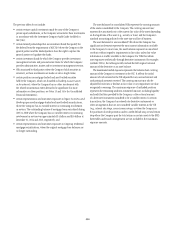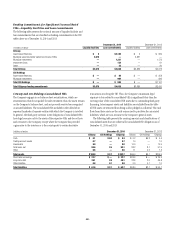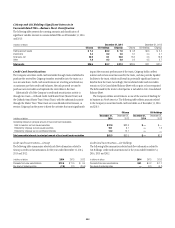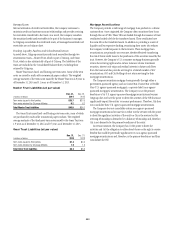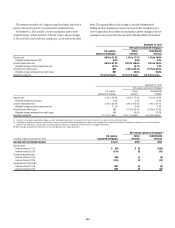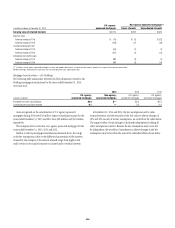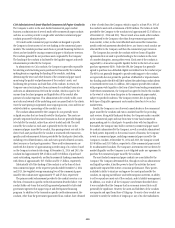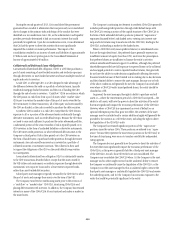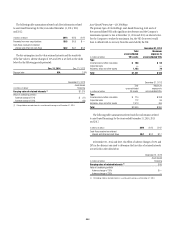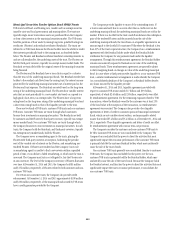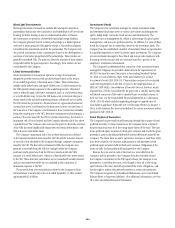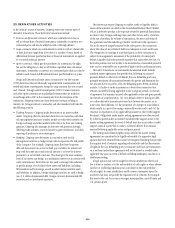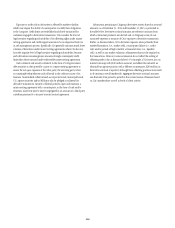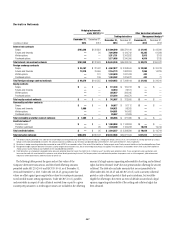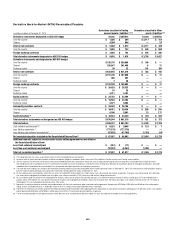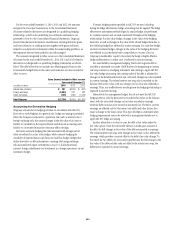Citibank 2014 Annual Report Download - page 257
Download and view the complete annual report
Please find page 257 of the 2014 Citibank annual report below. You can navigate through the pages in the report by either clicking on the pages listed below, or by using the keyword search tool below to find specific information within the annual report.240
During the second quarter of 2013, Citi consolidated the government
guaranteed loan conduit it administers that was previously not consolidated
due to changes in the primary risks and design of the conduit that were
identified as a reconsideration event. Citi, as the administrator and liquidity
provider, previously determined it had an economic interest that could
potentially be significant. Upon the reconsideration event, it was determined
that Citi had the power to direct the activities that most significantly
impacted the conduit’s economic performance. The impact of the
consolidation resulted in an increase of assets and liabilities of approximately
$7 billion each and a net pretax gain to the Consolidated Statement of
Income of approximately $40 million.
Collateralized Debt and Loan Obligations
A securitized collateralized debt obligation (CDO) is a VIE that purchases a
pool of assets consisting of asset-backed securities and synthetic exposures
through derivatives on asset-backed securities and issues multiple tranches of
equity and notes to investors.
A cash CDO, or arbitrage CDO, is a CDO designed to take advantage of
the difference between the yield on a portfolio of selected assets, typically
residential mortgage-backed securities, and the cost of funding the CDO
through the sale of notes to investors. “Cash flow” CDOs are entities in which
the CDO passes on cash flows from a pool of assets, while “market value”
CDOs pay to investors the market value of the pool of assets owned by the
CDO at maturity. In these transactions, all of the equity and notes issued by
the CDO are funded, as the cash is needed to purchase the debt securities.
A synthetic CDO is similar to a cash CDO, except that the CDO obtains
exposure to all or a portion of the referenced assets synthetically through
derivative instruments, such as credit default swaps. Because the CDO does
not need to raise cash sufficient to purchase the entire referenced portfolio,
a substantial portion of the senior tranches of risk is typically passed on to
CDO investors in the form of unfunded liabilities or derivative instruments.
The CDO writes credit protection on select referenced debt securities to the
Company or third parties. Risk is then passed on to the CDO investors in
the form of funded notes or purchased credit protection through derivative
instruments. Any cash raised from investors is invested in a portfolio of
collateral securities or investment contracts. The collateral is then used
to support the obligations of the CDO on the credit default swaps written
to counterparties.
A securitized collateralized loan obligation (CLO) is substantially similar
to the CDO transactions described above, except that the assets owned by
the VIE (either cash instruments or synthetic exposures through derivative
instruments) are corporate loans and to a lesser extent corporate bonds,
rather than asset-backed debt securities.
A third-party asset manager is typically retained by the CDO/CLO to select
the pool of assets and manage those assets over the term of the VIE.
The Company earns fees for warehousing assets prior to the creation of
a “cash flow” or “market value” CDO/CLO, structuring CDOs/CLOs and
placing debt securities with investors. In addition, the Company has retained
interests in many of the CDOs/CLOs it has structured and makes a market in
the issued notes.
The Company’s continuing involvement in synthetic CDOs/CLOs generally
includes purchasing credit protection through credit default swaps with
the CDO/CLO, owning a portion of the capital structure of the CDO/CLO in
the form of both unfunded derivative positions (primarily “super-senior”
exposures discussed below) and funded notes, entering into interest-rate
swap and total-return swap transactions with the CDO/CLO, lending to the
CDO/CLO, and making a market in the funded notes.
Where a CDO/CLO entity issues preferred shares (or subordinated notes
that are the equivalent form), the preferred shares generally represent an
insufficient amount of equity (less than 10%) and create the presumption
that preferred shares are insufficient to finance the entity’s activities
without subordinated financial support. In addition, although the preferred
shareholders generally have full exposure to expected losses on the collateral
and uncapped potential to receive expected residual returns, they generally
do not have the ability to make decisions significantly affecting the entity’s
financial results because of their limited role in making day-to-day decisions
and their limited ability to remove the asset manager. Because one or both
of the above conditions will generally be met, the Company has concluded,
even where a CDO/CLO entity issued preferred shares, the entity should be
classified as a VIE.
In general, the asset manager, through its ability to purchase and sell
assets or—where the reinvestment period of a CDO/CLO has expired—the
ability to sell assets, will have the power to direct the activities of the entity
that most significantly impact the economic performance of the CDO/CLO.
However, where a CDO/CLO has experienced an event of default or an
optional redemption period has gone into effect, the activities of the asset
manager may be curtailed and/or certain additional rights will generally be
provided to the investors in a CDO/CLO entity, including the right to direct
the liquidation of the CDO/CLO entity.
The Company has retained significant portions of the “super-senior”
positions issued by certain CDOs. These positions are referred to as “super-
senior” because they represent the most senior positions in the CDO and, at
the time of structuring, were senior to tranches rated AAA by independent
rating agencies.
The Company does not generally have the power to direct the activities of
the entity that most significantly impact the economic performance of the
CDOs/CLOs, as this power is generally held by a third-party asset manager
of the CDO/CLO. As such, those CDOs/CLOs are not consolidated. The
Company may consolidate the CDO/CLO when: (i) the Company is the asset
manager and no other single investor has the unilateral ability to remove
the Company or unilaterally cause the liquidation of the CDO/CLO, or the
Company is not the asset manager but has a unilateral right to remove the
third-party asset manager or unilaterally liquidate the CDO/CLO and receive
the underlying assets, and (ii) the Company has economic exposure to the
entity that could be potentially significant to the entity.


